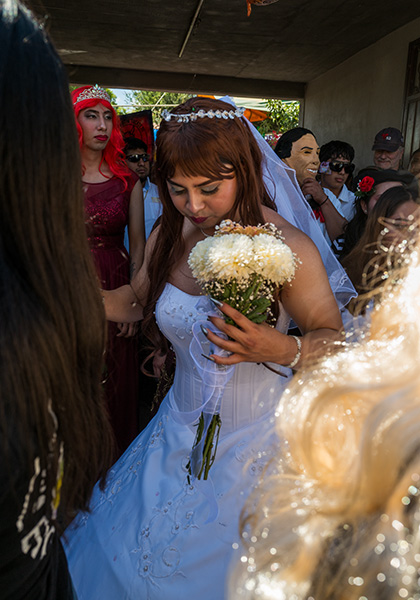I like artwork that defies predictability and traverses emotional landscapes. Two recent paintings from our studio Dos Venados in Oaxaca, exemplify this art.
Amy Córdova Boone has continued her fantastic storytelling through art in her latest piece, called El Peregrino Sagrado; “The Sacred Pilgrim,” (acrylic on canvas, 60 x 80 cm.) Her paintings emerge from deep within her psyche. This painting was inspired by a book she wrote and illustrated several years ago, entitled Talking Eagle and the Lady of Roses, published by Steiner Books, NY.
The story of Guadalupe and Juan Diego is one of the most revered and iconic tomes in Mexican Catholic tradition. It dates back to December 9-12, 1531, when according to tradition, Juan Diego, a devout indigenous man, experienced a series of miraculous encounters with the Virgin Mary on Tepeyac Hill near present-day Mexico City.
During the encounters, the Virgin Mary, appearing as a young indigenous woman, instructed Juan Diego to go to the Bishop and request the construction of a church in her honor on Tepeyac Hill. Initially, the Bishop was skeptical of Juan Diego's claims, but after a series of miraculous occurrences, including the blooming of Castilian roses in the middle of winter and the imprint of the Virgin's image on Juan Diego's tilma (cloak), the Bishop was convinced of the authenticity of Juan Diego's visions.
The image of Our Lady of Guadalupe imprinted on Juan Diego's tilma became a symbol of faith and unity for the Mexican people. It is said to contain layers of symbolism that spoke directly to the indigenous population, bridging the gap between their traditional beliefs and Catholicism.
The Basilica of Our Lady of Guadalupe was eventually built on Tepeyac Hill, becoming one of the most important pilgrimage sites in the Americas. The tilma of Juan Diego, with the miraculous image of Our Lady of Guadalupe, remains on display in the basilica to this day, attracting millions of visitors each year.
The story of Juan Diego and Our Lady of Guadalupe is not only a cornerstone of Mexican Catholicism but also a testament to the power of faith, miracles, and the enduring presence of the divine in everyday life.
Within my own oil paintings, I hope to surprise an audience, and do this by occasionally shifting artistic direction. The last few years my work has been somber and introspective. I made a series of "Memento Mori" paintings, where skeletal figures grapple symbolically with mortality. Recently, after I felt closure, my art has taken a dramatic turn towards vibrancy and celebration⏤exemplified by my most recent large piece, Two Dancers at a Fiesta, (oil on canvas, 80 x 100 cm.) It is in a world bursting with color and life. The canvas pulsates with the energy of the dance floor, as two figures whirl and twirl amidst a jubilant fiesta atmosphere. The subjects dance along with the brilliant colors and bold twirling designs. Even the floor is bursting with vibrancy. Gone are the solemn reminders of mortality; instead, we revel in the joyous rhythms of corporeal existence.
This shift is not only in artistic evolution but also the embrace of multifaceted human experience. Through my paintings, I embrace both the darkness and the light, finding beauty and meaning in every aspect of life's tapestry.
To see Amy and Steven´s Mexico inspired work, go to Dos Venados Studio



















































